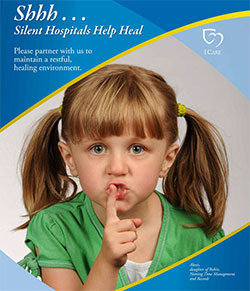In Search of Silence: Noise Reduction Efforts Afoot
Simon and Garfunkel’s “The Sound of Silence” was extremely popular in the mid-1960s--in fact, the song was arguably one of the most iconic of its generation. Today, for hospitals across the country, the “sounds of silence” are just as momentous--they’re one of the figurative gold standards caregivers chase in the quest to achieve higher levels of patient satisfaction.
That’s because research continues to link quiet hospital environments not only with improved patient healing and satisfaction scores, but also with medical staff satisfaction. Even so, in bustling patient units that are typically at or over 100 percent capacity, a steady stream of visitors, staff, and the bells and whistles of high-tech equipment can make “quiet” pretty elusive. Still, it’s a challenge health care systems must overcome, especially with the advent of the national HCAHPS (Hospital Consumer Assessment of Healthcare Providers and Systems) surveys, which report patients’ perspectives of their hospital experiences--noise included. 
In keeping with URMC’s commitment to deliver a patient- and family-centered brand of care, a subcommittee formed last fall to explore ways to lower noise levels and foster more positive experiences for our patients. The committee moved swiftly to implement a number of new initiatives, from dimming lights (studies have shown that low lighting promotes quiet), to piloting the use of special, acoustic ceiling tiles that absorb sound, to asking patients to wear headphones if watching TV late at night.
HCAHPS scores, fortunately, have indicated that the committee’s efforts are making a difference. A recent report showed that the percentage of patients saying their unit was “always quiet” at night hovers around 44 percent, matching the highest levels Strong Memorial has achieved since measurement began in 2008. (Of note, HCAHPS surveys only credit hospitals when their patients respond “always” to the survey prompts--other positive responses, such as "usually,” won’t bolster a score.)
“Obviously, we’ve made steady progress in a lot of areas on the HCAHPS survey, but noise reduction remains one of our greatest challenges,” said Jackie Beckerman, director of the Strong Commitment. “The important thing is that patients know we are working on it, and that we’re actively seeking their input on how to build a better environment.”
Armed with patient feedback, the URMC noise reduction committee continues to make improvements. In January, the committee launched its “Shhh!” campaign; debuting posters (sample above) featuring URMC staff members’ kids putting a finger to their lips. Placed throughout the medical center, the signs remind visitors and staff how important a quiet atmosphere is for patients.
While the poster campaign is the most visible piece of our noise-reduction effort, behind the scenes, staff are engaged in a number of other initiatives--even looking for garbage bags that make little noise when snapped open. Other efforts include:
• As “sleep hygiene” becomes better understood, there’s a whole school of thought about how to make hospitals more restful. The facilities department is working closely with consultants, who will be making recommendations on improved unit configurations (that is, how to locate certain activities away from areas where patients are sleeping) and replacement building materials (flooring alternatives, door closing devices, etc.) that can cut down on noise.
• Nurse manager Kristen Cardona, R.N., is piloting a “white noise” effort on 7-3600. Her team is using the speaker system to pipe in subtle background noise throughout the unit, helping to drown out other sounds. Installed in October, the system has elicited positive reviews from patients.
• New, softer rubber-based flooring will be installed on 7-1400 hallway areas in an effort to lessen traffic noise. Another perk: Housekeeping crews can clean the new surface just by wet-mopping, reducing the need for loud machines.
One of the more widespread initiatives has been a five-unit pilot of “comfort kits.” Staff on 5-1400, 6-1200, 6-3400, 6-3600, and 7-1200 routinely pass out the kits, which include ear plugs, eye masks, and ear buds for use when watching TV or listening to radio, plus a handout explaining our efforts to provide a more restful environment, and suggestions on how patients can take steps to reduce noise levels in their own rooms.
The kits have been so well received, they’ll be rolled out to all units in the weeks ahead.
“Though we’re clearly excited by the progress we’ve made so far, we know we still have a long ways to go,” said Juliette Goodwin of the Space Planning department, who co-chairs the noise reduction committee with Larry Weidner from Facilities.
“Many of the comments we receive from patients still cite staff conversation as a big part of the noise issue,” she added. “Really, it’s all of our responsibility to remember that this is a hospital, and that we can, and must, help create a better environment for our patients by keeping our voices and conversations at a reasonable level, especially at night.”
Molly Miles |
3/1/2012
You may also like